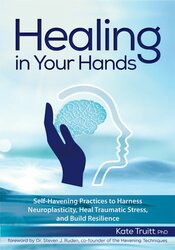How to Use CPR for the Amygdala in Your Practice
Use this FREE worksheet to help clients decrease emotional reactivity and stress

A helpful coping tool to decrease emotional reactivity and stress in clients is CPR for the Amygdala® (short for Creating Personal Resilience for the Amygdala). This is a program Dr. Kate Truitt and her colleagues developed to help people show up for themselves in a loving, proactive way when the survival brain starts taking over. It’s a simple, yet effective, brain hack that can help bring you back into the resilient zone quickly.
CPR for the Amygdala is designed to help your clients regain physical and emotional balance when they find themselves on those neural freeways of stress. It uses the mindful touch from self-havening in combination with “brain games” that redirect their thoughts away from the emotionally activating experience. Brain games are essentially any form of cognitive distraction that occupies the working memory resources.This is important, because when a client begins moving into survival mode, they are using all of their working memory resources to compare the current stressor to any stressful, painful, or distressing experiences from their past.
An easy way to begin integrating CPR for the Amygdala into your practice is to keep in mind the acronym SNAP, as though you’re going to snap the amygdala out of a stress reaction. These are the four foundational steps of the CPR for the Amygdala protocol:
CPR for the Amygdala is designed to help your clients regain physical and emotional balance when they find themselves on those neural freeways of stress. It uses the mindful touch from self-havening in combination with “brain games” that redirect their thoughts away from the emotionally activating experience. Brain games are essentially any form of cognitive distraction that occupies the working memory resources.This is important, because when a client begins moving into survival mode, they are using all of their working memory resources to compare the current stressor to any stressful, painful, or distressing experiences from their past.
An easy way to begin integrating CPR for the Amygdala into your practice is to keep in mind the acronym SNAP, as though you’re going to snap the amygdala out of a stress reaction. These are the four foundational steps of the CPR for the Amygdala protocol:
- Sense into the experience of emotional activation, distress, or disturbance.
- Notice the intensity of the experience and rank it on the scale of 0–10.
- Apply the self-havening touch.
- Preoccupy your brain with brain games to redirect your attention and focus.
Ready to build your personalized CPR program?

Written by Dr. Kate Truitt, a psychologist, neuroscientist, and trauma expert, Healing in Your Hands is the first book of its kind to integrate the neuroscience of trauma with cutting-edge research on self-havening – a groundbreaking technique that draws on the power of mindful touch to heal even the most profound traumatic stress. It weaves together powerful client stories, insights from the field of neuroscience, and personalized havening practices to create a complete self-healing program that anyone can use.
Meet the Expert:
Kate Truitt, PhD, MBA, s a licensed clinical psychologist and applied neuroscientist, and she holds an MBA in healthcare administration. She speaks internationally on topics related to the neuroscience of trauma, stress, and resilience. Dr. Kate knows that when we choose to let every moment of adversity strengthen and empower us, we are choosing to become our strongest and most inspired selves. At the heart of her approach to mental health and wellness is the NeuroTriad Model, which integrates three key pillars: Neuroscience-based methods, trauma-informed practices, and a resilience-focused approach. These components, when taken together, empower you to become a proactive participant in your transformational journey as you heal from the past, empower yourself in the present, and build for the future you want.
Learn more about her educational products, including upcoming live seminars, by clicking here.
Learn more about her educational products, including upcoming live seminars, by clicking here.






